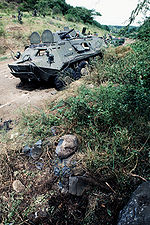
Caribbean
The Caribbean (/ˌkærɪˈbiːən, kəˈrɪbiən/ KARR-ih-BEE-ən, kə-RIB-ee-ən, locally /ˈkærɪbiːæn/ KARR-ih-bee-an;[4] Spanish: el Caribe; French: les Caraïbes; Dutch: de Caraïben) is a subregion of the Americas that includes the Caribbean Sea and its islands, some of which are surrounded by the Caribbean Sea[5] and some of which border both the Caribbean Sea and the North Atlantic Ocean;[6] the nearby coastal areas on the mainland are sometimes also included in the region. The region is south-east of the Gulf of Mexico and Northern America, east of Central America, and north of South America.
This article is about the group of islands. For the body of water surrounding them, see Caribbean Sea. For the Indigenous inhabitants of the Caribbean or people of Caribbean descent, see Caribbean people. For other uses, see Caribbean (disambiguation).Area
239,681 km2 (92,541 sq mi)
151.5/km2 (392/sq mi)
Afro-Caribbean, Latino or Hispanic, (Spanish, Portuguese, Criollo, Mestizo, Mulatto, Pardo, and Zambo), Indian, European, Chinese, Jewish, Arab, Amerindian, Javanese,[3] Hmong, Multiracial
029 – Caribbean419 – Latin America and the Caribbean019 – Americas001 – World
Situated largely on the Caribbean Plate, the region has more than 700 islands, islets, reefs, and cays. Island arcs delineate the northern and eastern edges of the Caribbean Sea:[7] the Greater Antilles in the north and the Lesser Antilles, which includes the Leeward Antilles, in the east and south. The nearby Lucayan Archipelago, comprising The Bahamas and the Turks and Caicos Islands, is considered to be a part of the Caribbean despite not bordering the Caribbean Sea. All the islands in the Antilles plus the Lucayan Archipelago form the West Indies, which is often interchangeable with the term Caribbean. On the mainland, Belize, the eastern and northern coasts of Central and South American countries such as the Bay Islands Department of Honduras, the North and South Caribbean Autonomous Regions of Nicaragua, the Limón Province of Costa Rica, and the Archipelago of San Andrés, Providencia and Santa Catalina of Colombia are also considered culturally Caribbean.[8] French Guiana, Guyana, Panama, and Suriname are often included as parts of the Caribbean due to their political and cultural ties with the region.
Geopolitically, the islands of the Caribbean are often regarded as a subregion of North America, though sometimes they are included in Middle America or left as a subregion of their own[9][10] alternately, the term "Caribbean" may have the intended exclusion, or even unintentional inclusion as part of Latin America. Generally the Caribbean area is organized into 33 political entities, including 13 sovereign states, 12 dependencies, historical disputed territories have existed, and seven other overseas territories. From 15 December 1954, to 10 October 2010, there was a territory known as the Netherlands Antilles composed of five islands, all of which were Dutch dependencies.[11] From 3 January 1958, to 31 May 1962, there was also a short-lived political union called the British West Indies Federation composed of ten English-speaking Caribbean territories, all of which were then British dependencies.
Because of a history of waves of immigration brought by colonization by the Spanish, English, Dutch, and French, the Atlantic slave trade from Africa, and Indentured servitude from Asia, as well as modern immigration, the modern Caribbean is one of the most ethnically diverse regions on the planet with persons of all these ethnic backgrounds.
Etymology and pronunciation[edit]
The region takes its name from that of the Caribs, an ethnic group present in the Lesser Antilles and parts of adjacent South America at the time of the Spanish conquest of the Americas.[12]
The two most prevalent pronunciations of "Caribbean" outside the Caribbean are /ˌkærɪˈbiːən/ (KARR-ə-BEE-ən), with the primary stress on the third syllable, and /kəˈrɪbiən/ (kə-RIB-ee-ən), with the stress on the second. Most authorities of the last century preferred the stress on the third syllable.[13] This is the older of the two pronunciations, but the stressed-second-syllable variant has been established for over 75 years.[14] It has been suggested that speakers of British English prefer /ˌkærɪˈbiːən/ (KARR-ə-BEE-ən) while North American speakers more typically use /kəˈrɪbiən/ (kə-RIB-ee-ən),[15] but major American dictionaries and other sources list the stress on the third syllable as more common in American English too.[16][17][18][19] According to the American version of Oxford Online Dictionaries, the stress on the second syllable is becoming more common in UK English and is increasingly considered "by some" to be more up to date and more "correct".[20]
The Oxford Online Dictionaries claim that the stress on the second syllable is the most common pronunciation in the Caribbean itself, but according to the Dictionary of Caribbean English Usage, the most common pronunciation in Caribbean English stresses the first syllable instead, /ˈkærɪbiæn/ (KARR-ih-bee-an).[4][20]
The word "Caribbean" has multiple uses. Its principal ones are geographical and political. The Caribbean can also be expanded to include territories with strong cultural and historical connections to Africa, slavery, European colonisation and the plantation system.
Here are some of the bodies that several islands share in collaboration:















